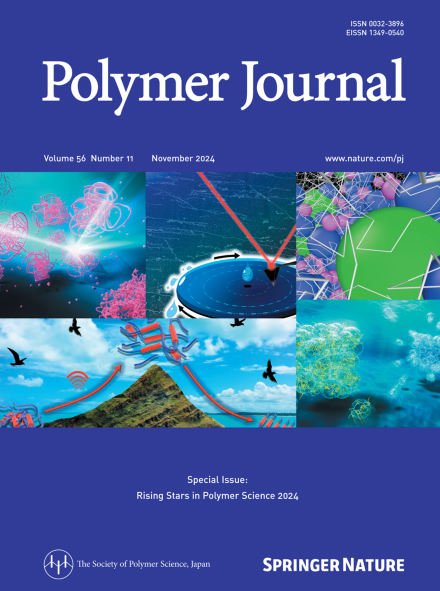用小角x射线散射研究了酚醛固化剂固化环氧树脂在有机膦催化剂下的交联不均匀性
IF 2.3
4区 化学
Q3 POLYMER SCIENCE
引用次数: 0
摘要
在本研究中,采用溶剂膨胀技术,用小角x射线散射(SAXS)成功地澄清了两种环氧树脂在有机膦催化剂下用酚醛固化剂固化的交联不均匀性。本文研究了三苯基膦(TPP)和四苯基膦(TPPTTB)作为固化催化剂。在完全四氢呋喃(THF)膨胀状态下的SAXS谱清楚地揭示了两种树脂之间的差异。凝胶化的早期、中期和后期的分布可以用代表聚合物链交联不均匀性和浓度波动的结构函数的总和来有效地解释。此外,曲线的变化表明,非均匀性的特征尺寸与较小的低交联密度区域的尺寸有关。两种树脂的网孔尺寸的相关长度减小到1 nm。这些结果证实了形成了发育良好的交联网络结构。此外,TPP-和tppttb固化树脂胶凝后期交联不均匀性的相关长度分别为1 nm和5 nm。因此,使用有机膦催化剂体系的酚醛固化环氧树脂在凝胶化后期由于不均匀性而表现出可thf膨胀的低交联密度区域。这一快速通信报道了在有机膦催化剂下,用酚醛固化剂固化的两种结构相同的环氧树脂在纳米尺度上交联不均匀性的差异的首次成功澄清。本文章由计算机程序翻译,如有差异,请以英文原文为准。

Crosslink inhomogeneity in epoxy resins cured with a phenolic hardener under organophosphine catalysts revealed by small-angle X-ray scattering
In this study, the crosslink inhomogeneities in two types of epoxy resins cured with a phenolic hardener under organophosphine catalysts were successfully clarified by small-angle X-ray scattering (SAXS) using a solvent-swelling technique. Herein, triphenylphosphine (TPP) and tetraphenylphosphonium tetra-p-tolylborate (TPPTTB) were investigated as the curing catalysts. The SAXS profiles in a fully tetrahydrofuran (THF)-swollen state clearly revealed a difference between the two types of resins. The profiles at the early, middle, and late stages of gelation were effectively explained by a sum of structural functions representing the crosslinking inhomogeneity and concentration fluctuations of the polymer chains. Furthermore, the change in the profiles indicated that the characteristic size of inhomogeneity was associated with the size of the minor, low-crosslink density region. The correlation lengths of the mesh size decreased to 1 nm for both resins. These results confirmed the formation of a well-developed crosslinked network structure. Moreover, the correlation lengths of the crosslink inhomogeneity at the late stage of gelation were 1 and 5 nm for the TPP- and TPPTTB-cured resins, respectively. Thus, the phenolic-cured epoxy resins using an organophosphine catalyst system exhibited a THF-swellable, low crosslink density region due to inhomogeneity at the late stage of gelation. This rapid communication reports the first successful clarification of the difference in the crosslink inhomogeneity at the nanometer scale for two types of structurally identical epoxy resins cured with a phenolic hardener under organophosphine catalysts.
求助全文
通过发布文献求助,成功后即可免费获取论文全文。
去求助
来源期刊

Polymer Journal
化学-高分子科学
CiteScore
5.60
自引率
7.10%
发文量
131
审稿时长
2.5 months
期刊介绍:
Polymer Journal promotes research from all aspects of polymer science from anywhere in the world and aims to provide an integrated platform for scientific communication that assists the advancement of polymer science and related fields. The journal publishes Original Articles, Notes, Short Communications and Reviews.
Subject areas and topics of particular interest within the journal''s scope include, but are not limited to, those listed below:
Polymer synthesis and reactions
Polymer structures
Physical properties of polymers
Polymer surface and interfaces
Functional polymers
Supramolecular polymers
Self-assembled materials
Biopolymers and bio-related polymer materials
Polymer engineering.
 求助内容:
求助内容: 应助结果提醒方式:
应助结果提醒方式:


